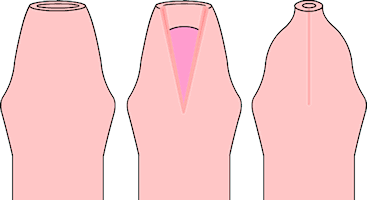|
This website focuses on the MTC method and strongly recommends it. It does not recommend surgical foreskin reconstruction at all, but below is the most commonly performed surgical method, as well as information about "touch-up" surgery: |
Surgical reconstruction
|
Surgical foreskin reconstruction has remained largely unchanged since Celsus first described the procedure 2000 years ago. An incision is made around the base of the penis and the penile shaft is denuded (in other words, the skin is peeled off), leaving the shaft skin attached only beneath the glans penis. This skin is then pulled forward to replicate a foreskin. To tighten the new foreskin and improve its contour, a wedge-shaped section may be removed and the opening sutured shut. Skin is then harvested from the scrotum and grafted onto the penis to patch the missing shaft skin. This is performed as a series of three operations, followed by several sessions of electrolysis to kill the hair follicles in the grafted scrotal skin. The cost of the procedure is high, upwards of $25,000 in the United States, and it has a poor success rate, with 30% to 40% of patients requiring multiple attempts. Even when the operation is successful, because of scarring and extensive tissue damage, the results are often neither visually nor functionally pleasing. It is for these reasons that most doctors now recommend non-surgical restoration possibly followed by minor "touch-up" surgery. |
Touch-up surgery
|
Although they are not very commonly performed, "touch-up" or "finishing" surgeries are available for those that have completed non-surgical foreskin restoration and want to make their new foreskins look as natural as possible:
|

Tightening the foreskin by removing a wedge
Who to contact
|
Whether you are interested in full reconstruction or only touch-ups, you should consult with a urologist experienced in foreskin reconstruction. It is beyond the training of an ordinary plastic surgeon.
Contact |
